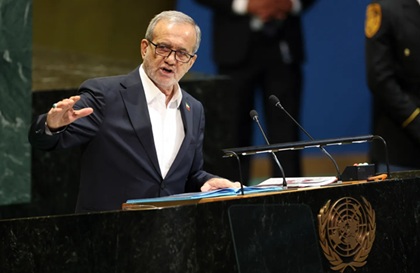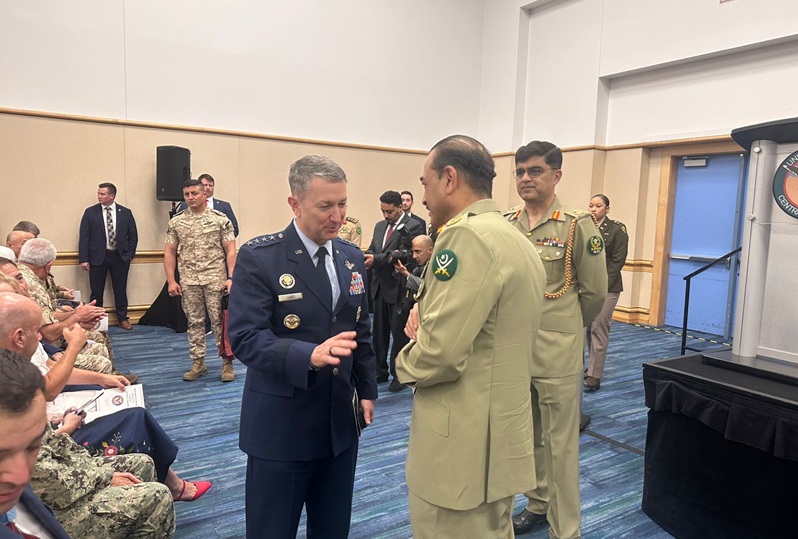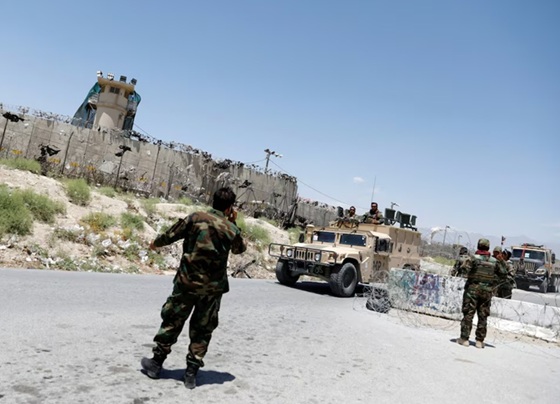On September 24, 2025, the 80th session of the United Nations General Assembly (UNGA) in New York became the stage for a surprising diplomatic moment: Iranian President Masoud Pezeshkian openly endorsed the newly minted mutual defense pact between Pakistan and Saudi Arabia. Hailing the agreement as a “good start” and a foundation for “a comprehensive regional security system with the cooperation of Muslim states of West Asia,” Pezeshkian’s remarks mark a pivotal shift in the geopolitics of the Middle East. This unexpected alignment among Iran, Saudi Arabia, and Pakistan—three nations historically divided by sectarian and strategic rivalries—could reshape the region’s security architecture, counter external threats, and challenge the dominance of Western powers in West Asia.
The Pakistan-Saudi Defense Pact: A Strategic Game-Changer
Signed on September 17, 2025, in Riyadh, the defense agreement between Saudi Crown Prince Mohammed bin Salman and Pakistani Prime Minister Shehbaz Sharif establishes a NATO-style mutual defense framework. The pact stipulates that an armed attack on either nation will be treated as an attack on both, committing them to joint defense efforts. Pakistani Defense Minister Khawaja Asif’s statement that Islamabad’s nuclear arsenal would be “made available” to Saudi Arabia in times of need has sent ripples across global capitals, effectively extending Pakistan’s nuclear umbrella to the Gulf kingdom.
The agreement goes beyond mutual defense, encompassing a “comprehensive spectrum” of cooperation, including joint military exercises, intelligence sharing, counterterrorism operations, and defense technology transfers. It also leaves the door open for other Muslim-majority nations—potentially Turkey, Indonesia, or even Qatar—to join, framing the pact as a defensive alliance to deter aggression, particularly from Israel, which has intensified strikes across the region since October 2023.
The pact’s roots lie in deepening Saudi-Pakistani ties, built on decades of economic and military collaboration. Saudi Arabia’s substantial investments in Pakistan, including a $25 billion pledge in 2018 for energy and infrastructure, have bolstered Islamabad’s economy amid domestic challenges. For Riyadh, Pakistan’s battle-tested military and nuclear capabilities offer a hedge against vulnerabilities exposed by attacks like the 2019 Abqaiq oil facility strike, widely attributed to Iran or its proxies.
Iran’s Endorsement: A Diplomatic Breakthrough
Pezeshkian’s UNGA address was a carefully crafted blend of defiance and diplomacy. While condemning Israel’s recent attacks on Qatar, Syria, Yemen, and Iran itself—including a September 2025 strike on Doha—he framed the Pakistan-Saudi pact as a unifying step for Muslim states. This stance reflects Iran’s evolving foreign policy under Pezeshkian, who has prioritized regional de-escalation since taking office. His August 2025 visit to Pakistan, where agreements on border security and trade were signed, laid the groundwork for this alignment. A subsequent phone call on September 18 between Iranian Foreign Minister Abbas Araghchi and Saudi Foreign Minister Prince Faisal bin Farhan further solidified this thaw, with both sides discussing the pact alongside bilateral ties.
Iran’s endorsement is significant for several reasons. First, it signals a détente in the decades-long Saudi-Iran rivalry, which has fueled proxy wars in Yemen, Syria, and Iraq. The 2023 China-brokered agreement to restore diplomatic ties between Tehran and Riyadh has gained momentum, with Pezeshkian’s remarks suggesting Iran sees value in a collective Muslim security framework over sectarian division.
Second, it positions Iran as a stakeholder in a regional alliance that could counter Israeli aggression, particularly after Iran’s own military actions, such as the June 2025 strike on the U.S. Al Udeid base in Qatar, highlighted the limits of U.S. protection in the Gulf.
Strategic Implications: A Shifting Regional Order
The Pakistan-Saudi defense pact, coupled with Iran’s approval, carries profound implications for West Asia and beyond. Below are the key dimensions of its impact:
1. Countering Israeli Aggression
The pact emerges against the backdrop of Israel’s escalating military operations, including strikes on Qatar in September 2025 and ongoing campaigns in Yemen, Syria, and Gaza since October 2023. By uniting Pakistan’s nuclear capabilities with Saudi Arabia’s financial clout, the agreement creates a formidable deterrent. Iran’s support amplifies this, suggesting a potential “united front” among Muslim states to counter Israel’s regional dominance, especially as U.S. backing for Israel strains Washington’s Gulf alliances.
2. Nuclear Dynamics and Global Concerns
Saudi Arabia’s access to Pakistan’s nuclear arsenal, even indirectly, escalates the stakes in the Gulf’s nuclear race. Riyadh has repeatedly stated it would pursue nuclear weapons if Iran weaponizes its program, a fear heightened by Tehran’s advancements toward 90% uranium enrichment. The pact could stabilize this dynamic by deterring Iran through Saudi-Pakistani alignment, but it also risks fueling an arms race if miscalculations occur. Globally, it complicates U.S.-India relations, as New Delhi views Pakistan’s nuclear commitments with suspicion, and underscores China’s growing influence, given its role in Pakistan’s nuclear program.
3. Reducing U.S. Influence
The pact reflects a broader erosion of U.S. dominance in the Gulf. The failure of U.S. defenses to protect Saudi Arabia from the 2019 Abqaiq attack and Washington’s restrained response to Iran’s 2025 Al Udeid strike have pushed Riyadh to seek alternative security partners. Pakistan’s role as a reliable ally, combined with Iran’s acquiescence, signals a multipolar shift, with Gulf states diversifying beyond Western guarantees. This could delay U.S.-backed initiatives like the India-Middle East-Europe Corridor (IMEC), as Saudi Arabia pivots toward regional alliances.
4. Economic and Geopolitical Ripple Effects
For Pakistan, the pact strengthens economic ties with Saudi Arabia, a critical investor amid Islamabad’s fiscal challenges. It also elevates Pakistan’s status as a security provider in the Muslim world, though it risks entanglement in Gulf conflicts like Yemen. For Saudi Arabia, the agreement addresses post-2019 vulnerabilities and diversifies its defense strategy. However, it unsettles India, which fears the pact could embolden Pakistan in bilateral disputes, potentially stalling regional projects like IMEC.
5. Risks of Escalation
While the pact aims to deter aggression, it carries risks. Pakistan’s involvement in Gulf conflicts could strain its resources and escalate tensions with India, particularly if New Delhi perceives the nuclear commitment as a threat. Similarly, Iran’s endorsement does not guarantee full alignment, as lingering distrust with Saudi Arabia could resurface in proxy theaters like Yemen. The inclusion of other states in the pact, while inclusive, could also complicate decision-making and heighten regional rivalries.
A Path Toward Muslim Unity?
Pezeshkian’s UNGA remarks frame the pact as a stepping stone to a broader West Asian security system, a vision that aligns with Iran’s push for regional self-reliance. By endorsing a Saudi-Pakistani initiative, Iran signals openness to multilateral cooperation, potentially including nations like Turkey or Qatar. This could stabilize oil markets, secure trade routes, and reduce proxy conflicts, but it requires careful diplomacy to avoid arms races or miscalculations. The pact also reflects a broader trend of Muslim-majority states seeking autonomy amid global power shifts. As U.S. influence wanes and China’s role grows, initiatives like this could redefine West Asia’s security landscape, prioritizing collective defense over external dependence. However, success hinges on managing internal rivalries and external pressures, particularly from Israel and its Western backers.
Conclusion: A Fragile but Promising Step
Iran’s applause for the Pakistan-Saudi defense pact at the UNGA marks a rare moment of convergence in a region long defined by division. By endorsing this alliance, Tehran positions itself as a partner in a nascent Muslim security framework, challenging the status quo of Western dominance and Israeli aggression. Yet, the pact’s success depends on navigating nuclear risks, regional rivalries, and global power dynamics.
For now, Pezeshkian’s words signal hope for unity, but the path to a stable West Asia remains fraught with challenges. As the region watches, the world waits to see if this alliance can deliver peace or ignite new tensions.
Discover more from Defence Talks | Defense News Hub, Military Updates, Security Insights
Subscribe to get the latest posts sent to your email.





